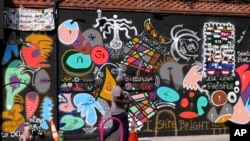In 1974, Harlem’s deserted streets and tumbledown tenements told the story of a neighborhood left behind. Decades of disinvestment had culminated in a mass exodus known as urban flight and residents watched as their wealthier, more educated counterparts left the New York City neighborhood in droves.
But the tide turned when Percy Sutton, then the Manhattan borough president and New York City’s highest-ranking Black elected official, launched a campaign to bring back vitality to the historically African American neighborhood that had been known as a global Black mecca of arts, culture and entrepreneurship.
It became known as Harlem Week and would go on to draw back those who had departed. On Sunday, organizers celebrated Harlem Week's 50th anniversary after 18 days of free programming that showcased all the iconic neighborhood has to offer.
Harlem Week stands as “the constant line through the last 50 years of America’s most historic Black neighborhood,” said the Rev. Al Sharpton, whose National Action Network is headquartered in the neighborhood. “The dream of Percy Sutton and his peers in government, arts, the church and other elements of Harlem lives on, stronger than ever.”
In the 1970s, Harlem demanded more than an ordinary festival, if it wanted a resurrection. Those who remained in Harlem during urban flight — mostly low-income, Black families — would turn on their televisions to constant despair: crime reports, bleak statistics and reporters who called their home a “sinking ship.”
Sutton knew Harlem was due for a revitalizing, uplifting moment.
That summer, Sutton rallied religious, political, civic and artistic leaders that included Tito Puente, Max Roach, Maya Angelou, James Baldwin, Harry Belafonte, Sidney Poitier, Ruby Dee and Lloyd Williams. Together, they devised an event that would pivot the spotlight from Harlem’s troubles to its vibrant legacy: Harlem Day.
Radio disc jockeys Hal Jackson and Frankie Crocker produced a concert at the plaza of the Harlem State Office Building, while actor Ossie Davis cut a ribbon at 138th street and 7th Avenue, announcing the start of the “Second Harlem Renaissance.”
The ribbon-cutting ceremony renamed 7th Avenue to Adam Clayton Powell Jr. Boulevard, named for the first African American elected to Congress from New York, marking the first time a New York City street took the name of a person of color.
“About two or three weeks later, Percy Sutton called us all and said it was such a successful day,” said Lloyd Williams, one of Harlem Day’s co-founders and the current president of the Greater Harlem Chamber of Commerce. “It meant so much to the other cities that were being deserted in Detroit and Baltimore, Washington and Chicago, that they asked if we would do it again on an annual basis.”
They did, and Harlem Day evolved into Harlem Weekend and eventually Harlem Week, which, before the pandemic, expanded to a full month of programming.
“Only in Harlem could a week be more than seven days,” said Williams, whose family has lived in Harlem since 1919.
This year's celebration featured entertainment, including a headlining set by hip-hop artist Fabolous, a tribute to Harry Belafonte and Broadway performances. Other concerts showcased jazz, reggae, R&B and gospel traditions nurtured in Harlem, alongside hundreds of food and merchandise vendors.
Organizers also included empowerment initiatives, such as financial literacy workshops and health screenings, at Harlem Health Village and the Children’s Festival. Every child who attended received a back-to-school backpack.
Harlem Week always has been a living tribute to Harlem’s history of greats, such as W.E.B. Du Bois, Langston Hughes, Augusta Savage and Aaron Douglas. It recognizes the Harlem Renaissance and Black Arts Movement and honors landmarks like the Apollo Theater and Schomburg Center for Research in Black Culture.
Many historians consider the late 1960s and the 1970s to be Harlem’s darkest years.
The area had been battered by unrest, including a 1964 riot that killed an unarmed Black teenager, Malcolm X’s assassination in 1965 and the turmoil after the Rev. Martin Luther King Jr.’s assassination in 1968. Household incomes fell dramatically and infant mortality rates were high.
“The neighborhood was blighted,” recalled Malik Yoba, an actor born in the Bronx in 1967 who grew up in Harlem and spent days playing in the dirt of vacant lots. Yoba attended school in the Upper East Side with peers who had country homes upstate in the Hamptons.
“I didn’t understand why where we lived looked so dramatically different than where they lived,” he said. “I knew something was wrong.”
But Harlemites are creatives and entrepreneurs, visionaries and leaders. Where others saw decline, they saw opportunity, and the determination to match Harlem with its potential ran high.
Yoba, now 56, built a career as an actor showcasing Harlem to audiences across the nation. His experiences with housing inequality also fueled his passion for real estate.
Yoba combats the effects of redlining through his company Yoba Development, which provides young people of color access to the industry and has active projects in Baltimore and New York City.
“When you grow up in disenfranchised and divested communities, you can’t see the forest through the trees,” Yoba said. “You can grow up believing that walking by burnt-down buildings is your birthright, as opposed to understanding that building is a business.”
Hazel Dukes, 92, a prominent New York civil rights activist and Harlem resident of 30 years, has spent her life fighting discrimination in housing and education. She lived in the same Harlem building as Sutton and organized alongside him, later becoming a national president of the NAACP in 1989.
“I know what it feels to be denied,” said Dukes, who was born and raised in Montgomery, Alabama, and endured Jim Crow segregation. She moved to New York City with her parents in the 1950s.
Today, property in Harlem is coveted, driven by gentrification and its enduring cultural appeal.
“There was a waiting list, because everybody wanted to live in Harlem,” Dukes said. “People want to come to Harlem before they transition from this world.”
